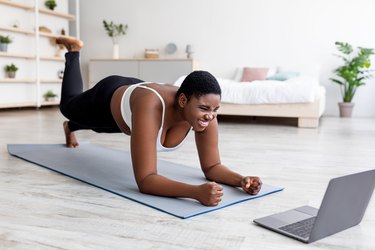
Having osteoarthritis in your hands can lead to pain, swelling and joints that feel stiff, according to the American Academy of Orthopaedic Surgeons. These symptoms can make using your hands — whether it's to open a jar of pickles or grab weights for a workout — seem like a big no-no.
"I commonly hear from patients that they avoid exercise for fear that they are causing damage to their hands or can make their arthritis worse," Amanda Walsh, MD, hand surgeon and assistant professor of orthopedic surgery at the Icahn School of Medicine at Mount Sinai, tells LIVESTRONG.com.
Video of the Day
Video of the Day
But holding off on working out is a mistake for anyone — including people with osteoarthritis (OA). If you have OA in your hands, you'll likely find that the more you move, the better it feels, says Theresa Marko, PT, DPT, a board-certified clinical specialist in orthopedic physical therapy in New York City.
"Exercising and using one's hands can actually be beneficial in preventing the progression of arthritis symptoms," Dr. Walsh points out.
If you don't work out, your joints will be more stiff, per the Mayo Clinic. Spend time exercising, and you'll strengthen your muscles, providing support to your joints — plus, you'll get all the other benefits that accompany exercise, such as increased energy, better sleep, improved balance and weight control, according to the Mayo Clinic.
That said, you may find that you want to make some modifications to your workout routine to avoid aggravating your hands. Here's what experts recommend.
1. Don’t Skip the Warm-Up
Before you grab the dumbbells or sink down into a push-up position, take some time to warm up.
"Just as with any other part of the body, warming up your hands and wrists is essential prior to working out," Dr. Walsh says.
Try doing some hand pumps, suggests Marko. "Open and close your hands over and over again," she says — doing this will help warm up your muscles and joints. Or move your wrists in a small circle, Dr. Walsh suggests. These types of gentle movements "are great ways to get warmed up and prevent injury," she says.
Skip this warm-up, and your joints will be stiff, which can decrease your grip strength, making it hard to hold on to equipment (like a barbell or hand weight), Marko points out.
Tip
If your joints in your hands hurt after a workout, they’re probably inflamed, Marko says. Calm down that inflammation by icing the area for 15 to 20 minutes, she recommends.
2. Reduce the Weight on Your Hands During Body-Weight Moves

Certain moves — like push-ups, downward-facing dog or anything where you're on your hands and knees — put a lot of your body weight over your flat hand. That can be painful, Marko says.
"The hand is going to be most stressed when it's flat on the ground, meaning the palm and all five fingers are interacting with the ground," says Joseph Lipsky, PT, DPT, a certified strength and conditioning specialist at Performix House in New York. It can be particularly hard on the thumb joint, near the base of the hand, Lipsky says.
Fortunately, some simple adjustments can help reduce the strain and aggravation. Try these tactics:
1. Hold Onto Something
Hold on to a dumbbell (one for each hand) while you're in the push-up position, Lipsky suggests. This adjustment reduces the stress on the thumb and hand, he says.
2. Make a Fist
Another option is to make a fist with your hands, instead of placing them flat on the ground, Marko says. That way, the weight will be on your knuckles instead of your extended fingers, she says.
3. Drop Down
If you're planking, you can reduce the strain on your hands by dropping down to your forearms, instead of having your arms fully extended, Dr. Walsh says.
"In general, modifications that avoid weight bearing through the painful area are helpful," she says.
4. Elevate Your Hands
If your hands are elevated, you can distribute the weight more so it's occurring in your wrist and the top of your hand, and not just your thumb, Lipsky says. So, instead of doing a traditional push-up or high plank, place your hands on a low surface like a couch or a table, he suggests.
"It's not as low [as the floor], so you're not putting all your weight on it," Marko says.
You can also try to do a wall push-up, she says.
5. Grab a Ball
Another modification is to do the move on top of a physio ball, Marko suggests. "That way, you don't have to put your hands on the ground. The ball is holding you up by giving you buoyancy on your stomach," she says.
Warning
“Exercises like handstand push-ups should be avoided in people with hand and wrist problems,” Dr. Walsh says, noting that hands and wrists simply aren’t meant to withstand full body weight for sustained periods.
3. Try These Modifications With Weights

If you're doing strength training with weights, you might find yourself needing to experiment a bit to figure out what works. But don't push yourself if a specific exercise is bothersome. "Find a different way to work out that body part," Dr. Walsh says.
Reduce the Weight
Start with the simplest shift: If you're feeling pain or discomfort, lower the weight, Marko says. "If that still hurts, then do just body weight. Just your arms alone are a weight," she says.
Limit the Lift
If a move is painful or difficult even with just body weight, limit the range of motion, Marko suggests. For instance, if you're doing a lateral raise, shoot for 45 degrees if you find 90 degrees challenging, she says.
What if It Hurts?
Some amount of pain isn’t necessarily cause for concern, Lipsky says. Think of a 1 to 10 pain scale, where one is mild discomfort and 10 is excruciating pain — it’s probably safe to keep going when you're between 1 and 4 on that scale, he says.
“Pain is often a normal response, especially when you’re just starting to work out with osteoarthritis,” Lipsky says. But tread more carefully when pain is between 5 and 7. And for pain that's a 7 or above, it's likely best to call it quits on the move. “There’s probably a better exercise we can choose for you, where you don't have to go through pain,” Lipsky says.
A little soreness after an exercise is OK, Dr. Walsh says. “If an exercise causes sharp pain during or afterward, that is a sign that a modification is needed,” she notes.
Consider Your Equipment
A pair of workout gloves may help you grip weights comfortably, Marko suggests. If grip is an issue, try using weights covered in silicone too, she says. Between the silicone covering and the gloves, you'll likely find it easier to hold on to the weights.
The versatility of kettlebells makes it a great piece of equipment, Lipsky says. "You can hold the handles of the kettlebell with one hand, you can hold it with two hands. You can even hold the actual circular part of the kettlebell," he says. That kind of hold will put less stress on your hands, since you'll be squeezing in with both hands, as if you were holding onto a big goblet, he notes.
If you find it difficult to hold onto weights, try using ankle weights around your wrist, Marko suggests. That way, your hands are free and you don't have to hold onto anything, but you can still strengthen your elbows, shoulders, biceps and triceps, Marko says. (You can also opt to use wrist weights.)
Finally, consider grabbing a towel when you're working with weights. You can wrap it around a dumbbell to make the handle thicker, or you can create a loop to hold the weight, Lipsky says. "Oftentimes, the thickness of something is the hardest part for people to handle," Lipsky says — using a towel allows you to create a flexible, thinner place to grasp.
Was this article helpful?
150 Characters Max
0/150
Thank you for sharing!
Thank you for your feedback!
Is this an emergency? If you are experiencing serious medical symptoms, please see the National Library of Medicine’s list of signs you need emergency medical attention or call 911.